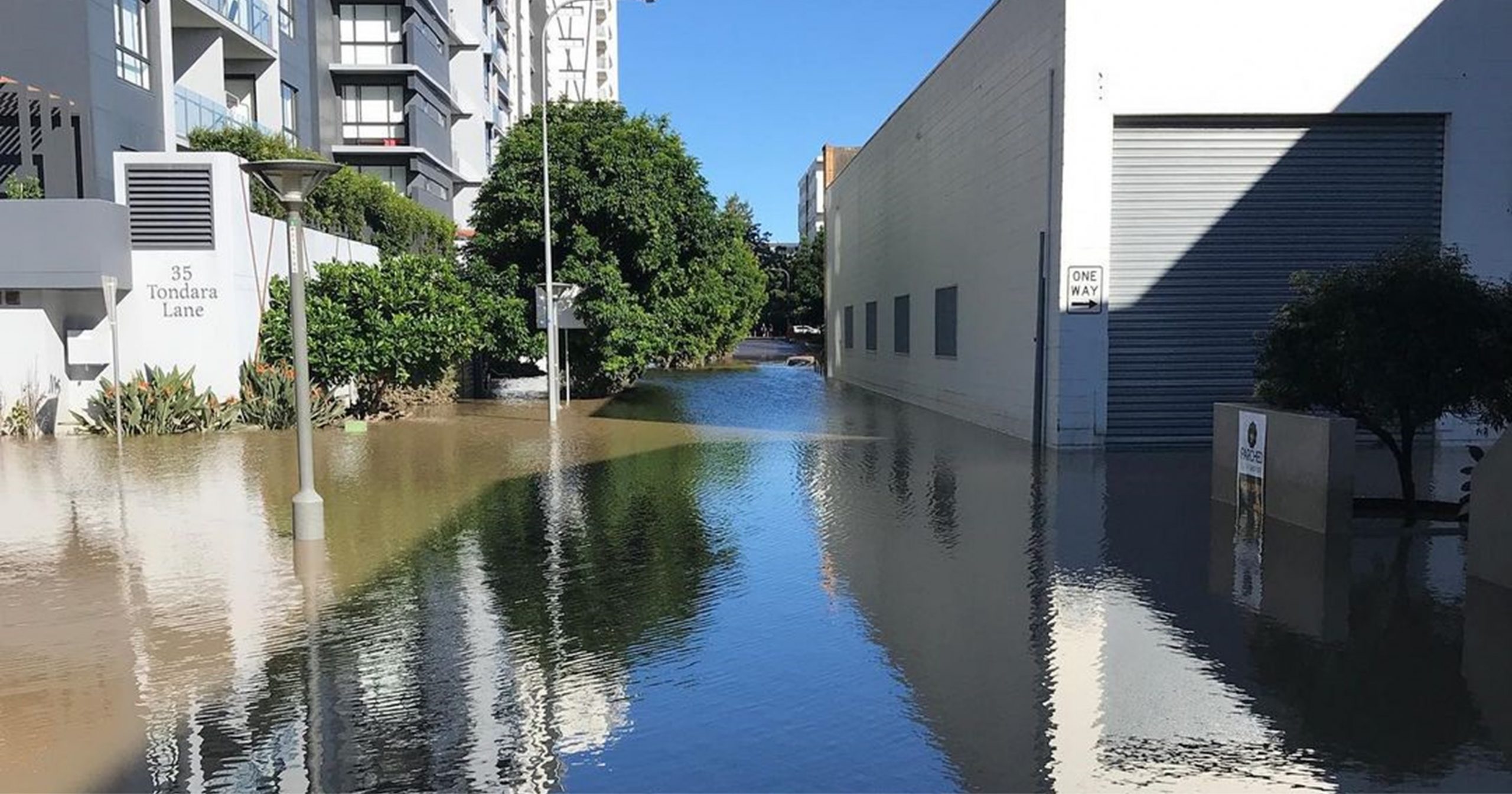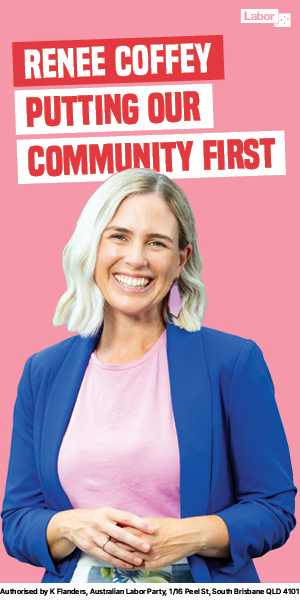Investing in community’s capacity
As I write, the West End community has again stepped up to assist those who have been hit hard by the floodwaters of last week.
Though we are all saying the flood height was lower than 2011 and 1974, there is still a legacy of repeated damage in our landscape, damage that costs individuals, the community, and the environment dearly.
Last flood, in 2011, there were 2132 houses impacted directly across 21 streets on Kurilpa Peninsula. This time the impact on high-rise developments from floodwaters and power cuts has been higher. People were stranded in their apartments for days. And we are still counting the damage, street by street.
In 2011 the ‘community’ – an amazing mix of individuals, local organisations and a four-day stream of mud-army volunteers, pulled together to do thousands of hours of clean-up work, food preparation and delivery. They also problem-solved about power cuts, transport cancellations, and provided assistance with applications for support packages. In that crisis response phase, the community delivered thousands of meals, and carted hundreds of tonnes of waste, except the tonnes the river haemorrhaged into Moreton Bay.
After the clean-up back then the big needs continued in various forms.
Taking stock – there were a variety of needs arising from flood impacts and these had to be assessed and met. The community needed capacity to survey and liaise with affected populations – in the affected streets, business areas, and schools, where children may have trauma impacts, and in the high-rise apartments, where body corporate issues became the focus.
Information hubs were essential for organising and matching needs for food, housing, mental health, and financial assistance, with resources across the Kurilpa Peninsula. Assistance desks were set up at local halls and in community centres, and these desks assisted people with Centrelink, Lifeline and welfare and housing support. West End Community House in Norfolk Road and MICAH were key hubs and a temporary hub was established at Sussex Street Uniting Church.
Connecting with people where people are visited, checked on and provided with various portals (drop-in centres, contact lists for calls) for connecting them with organisations or assistance. Over time, mental health issues emerged as people faced loss, trauma, and financial stress.
Communication in 2011 was mostly through local Councillor Helen Abrahams who was on the ground taking stock and following up with the ADF, Council and the State Government for practical assistance.
| Community infrastructure takes generations to build. The Croquet Club in Musgrave Park is there because of the work of Josephine Papi. Josephine devoted her days in the late 1800s and early 1900s to several issues – the welfare of returned soldiers from the Boer War, building Brisbane’s first children’s hospital. and the establishment of a Croquet Club for the croquet-playing citizens of South Brisbane. |
Our pollies step up
In 2022, the cooperation across all three levels of government by our representatives has been noteworthy. The combined efforts of Councillor for The Gabba, Jonathan Sri, Amy McMahon MP for South Brisbane, and Terri Butler MP, Federal member for Griffith has ensured information is being pooled and coordination challenges sorted.
People have been accessing on the ground assistance through information hubs with the paperwork involved in applying to government and insurance companies.
Micah Projects has coordinated accommodation and other supports for those affected by the flood, and West End Community House is hosting a Community Recovery Hub over the coming weeks. In addition, Community Friends, local businesses and other groups have provided food services. Kurilpa Futures set up a stall at Montague Markets to assist with coordination efforts. West End Community Association has provided a conduit to the offices of our elected representatives and a range of community organisations.
More information is available this time, but we are aware that it is still not enough. The flood warning system has been found wanting. Local flood models and elevations for ready access in the flood preparation stage were not accessible. We will know more about the flood build-up stage and the adequacy or not of the information provided as the weeks progress.
Out of all this short to medium-term effort by neighbours, groups, community organisations and our politicians, we can learn a lot about what needs to change. This flows onto a crucial piece of work, advocacy.
A bigger community voice
We know these disasters will continue, more intensely and more frequently, and community advocacy will have to ramp up to match this challenge. The peninsula needs to organise to make its voice heard about drawing the line, particularly on land use planning failures.
There are environmental limits that have not been accounted for seriously enough. We have a situation where accelerated population growth since 2000 has been accommodated mostly in flood-prone areas. Advocacy around planning solutions will be essential.
Governments come and go, but communities are embedded – they actively engage with their place and each other. So, a second advocacy area for the future will be for increased investment in community infrastructure. This encompasses soft infrastructure – the connections people build over time that include organisations, funds, donations and relationships – and the hard community infrastructure of centres, halls, vehicles, gurneys, web pages, those assets a community can mobilise to help itself through disasters.
Today’s examples of community infrastructure on the Peninsula have taken decades to build:
- Indigenous, ethnic and religious community organisations – Murri Watch, Greek, Cypriot, Vietnamese and multicultural associations; Islamic, Tongan and Christian places of worship.
- MICAH Projects, West End Community House in Community Plus.
- Residents and Business advocacy groups – Kurilpa Futures and West End Community Association, West End Traders Association, legal aid (Caxton Street),
- Food and housing organisations – Aboriginal hostels and community housing groups, Community Friends, Australian Pensioners and Superannuants League, community gardens and habitat groups, St Vincent de Paul.
- Schools and family support through Parents & Citizens Associations.
Recovery hubs 2011 & 2022
Recovery hubs are valuable crisis response centres. Their work makes a big difference in the first weeks and months following a disaster.
Back in 2011 we wanted to foster a better resourced, better prepared, and more resilient community across all sectors – apartments, businesses and detached housing. So the steps we undertook in the weeks following the clean-up then, are highly relevant now. For example, support via Centrelink, Lifeline, relief and assistance schemes for housing and welfare, access to charity funding and donations.
Specialist support:
- For businesses – assistance for businesses that demonstrate income loss, even those not directly flooded (assistance at this time extends only to directly impacted businesses);
- assistance to the increasing numbers of apartments with their body corporates across the peninsula, addressing questions about insurance, body corporate laws relating to levies for repairs, compensation, and dispute resolution where needed;
- Tenancy support in relation to the living conditions of rented premises, tenants’ rights and landlord obligations;
- Mental health support as issues emerge for residents and for specific populations including school children, businesses, vulnerable and isolated families and individuals.
Examples of other community development work include:
- Working with local residents to identify preferred community building activities;
- Supporting a local storytelling or recording project around the flood event to validate both loss and community strength; the development of activities and events to build connections between residents.
- Supporting the work of the local Flood Recovery Committee;
- Networking with other local Flood Recovery initiatives across Brisbane to learn from their experiences, offer West End’s learnings and explore models of community building.
Value of a community recovery working group
We have strong indicators of positive action on the ground in this 2022 recovery phase and of progress in problem-solving resident and business needs. There is much more to be done in this immediate phase.
Given the increasing frequency and severity of disasters, there are further bigger areas where strong advocacy is needed, such as:
- An accountable and effect land use planning scheme that is fit for purpose in a floodplain setting like Kurilpa Peninsula;
- Buy-back schemes for any areas deemed uninhabitable;
- Funding in the immediate term for more community development personnel, located within existing centres;
- Major investment in a scaled-up community asset and resource base that builds on existing community infrastructure, is fit for purpose, and supports the community to help itself in times of emergency, distress or disaster.
This advocacy work must feed into the bigger processes governing the city – including Town Plans, Emergency Planning, and Council budgets.
Investment in Community
The peninsula has been developed in a way that ignores the inevitability of extreme weather, so more clean-ups, chuck-outs, and replacement is disturbingly on the agenda in the future.
The whole system needs to change to prioritise community capacity-building. Government grants and asset building programs need to prioritise community infrastructure and Council needs greatly increased investment in staffing and resourcing for community development.
-
Greater recognition in the City Reconstruction process that community infrastructure is critical to community responsiveness.
-
Increased investment in supporting secure and long term ‘community infrastructure’ development and consolidation as a fundamental layer in all communities;
-
Systematic development of community infrastructure in all communities e.g. neighbourhood centres, community grants and embedded community development workers;
-
Disaster management plans for all communities at risk of disasters including floods, fires, heatwaves.
When enough is enough, yet we know there’s more to come, community-driven solutions will make all the difference.
Community organisations are coming together at a Flood Recovery meeting:
Saturday 19 March 9.30 to 11.00 am at Tangara, Sussex Street, West End



Image one by Nic Davies @nic_skip_ ; other images by Jan Bowman
Read related stories here – https://westender.com.au/discussing/news/brisbane-floods/


